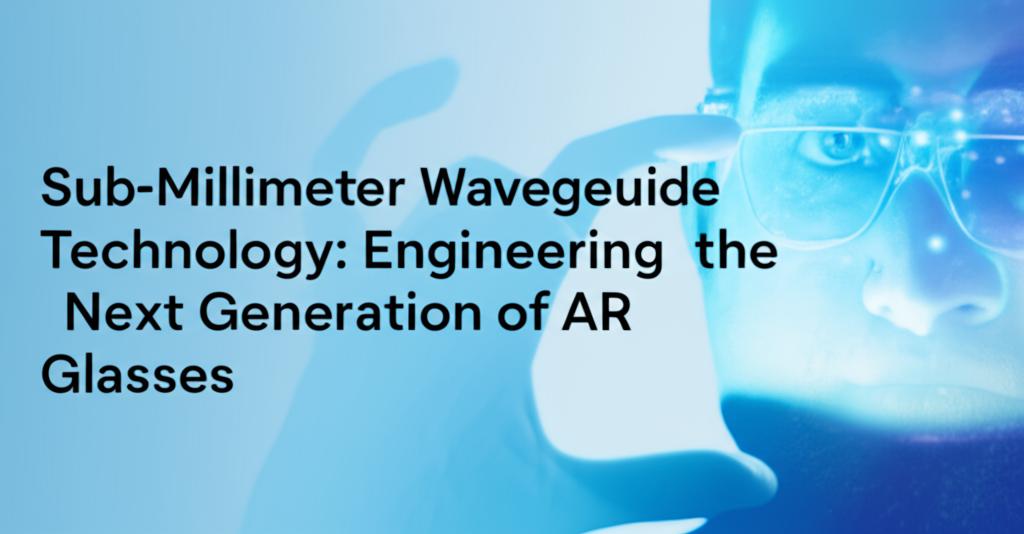Augmented reality (AR) is rapidly moving into everyday applications, from education and healthcare to gaming and entertainment. However, a key challenge for wider adoption has been the bulky and heavy nature of current AR devices, making them uncomfortable for extended use. Groundbreaking developments in sub-millimeter waveguide technology are now paving the way for AR glasses that are significantly thinner, lighter, and more powerful, promising to revolutionize how we interact with digital information and the world around us.
At the heart of this transformation is the optical waveguide. This technology is crucial for projecting virtual images into the user's field of view while maintaining a compact and lightweight form factor – essential for glasses that can be worn all day. Unlike traditional AR displays that rely on bulky external components like mirrors, waveguides direct light within the lens itself. This allows AR glasses to achieve a sleek appearance, similar in size and weight to standard eyeglasses.
The Single-Layer BreakthroughA significant hurdle in waveguide design has been chromatic dispersion, where different colors of light behave differently. This traditionally required stacking multiple layers of glass (often three to six), one for each primary color (red, green, and blue), inevitably adding to the device's thickness and weight.
Recently, researchers, notably a team from Pohang University of Science and Technology (POSTECH), have made a pivotal breakthrough by developing an achromatic metagrating. This innovation allows a single, ultra-thin layer of glass to handle all colors of light. The key lies in an array of nanoscale silicon-nitride (Si₃N₄) pillars. The precise geometry of these pillars, determined by sophisticated optimization algorithms, enables them to steer light with exceptional efficiency across the entire visible spectrum.
This single-layer waveguide can be incredibly thin – around 500 micrometers, roughly one-hundredth the diameter of a human hair. This dramatically reduces the bulk and complexity compared to traditional multi-layer designs. Beyond thinness, these advanced waveguides also maintain a comfortable "eyebox" – the area where the user's eye can move while still seeing a clear and stable image. This is crucial for a natural and comfortable viewing experience.
Benefits of Sub-Millimeter Waveguide TechnologyThe advantages of this new generation of waveguide technology are numerous:
- Reduced Size and Weight: The most immediate benefit is the creation of AR glasses that rival the form factor of conventional eyewear. This significantly reduces wearer fatigue, a major barrier to all-day use, and enhances user acceptance.
- Improved Visuals: The achromatic metagrating design virtually eliminates chromatic aberration (color blur), leading to brighter, clearer, and more uniform full-color images. This is a significant improvement over older multilayer optics.
- Simplified Manufacturing: The single-layer design simplifies the fabrication process. This simplification has the potential to lower production costs, making AR glasses more accessible to a wider market. It also points towards a more sustainable production chain.
- Enhanced User Experience: By being thinner, lighter, and providing better image quality, these waveguides contribute to a more immersive and comfortable AR experience. This opens the door for AR to seamlessly integrate into daily life for various applications.
While the progress is exciting, challenges remain. Engineers are continuously working on:
- Materials Science: Developing and refining materials, like specialized optical glass and polymers, that are thinner, lighter, and more efficient in guiding light.
- Design Optimization: Creating innovative waveguide designs, such as fully laminated layer structures with no air gaps, to eliminate the need for protective covers and to achieve wider fields of view (FOV). Companies are leveraging advanced in-house simulators and nanotechnology from the semiconductor industry to fine-tune light manipulation within the lens for optimal clarity and brightness.
- Manufacturing Processes: Advancing manufacturing techniques, like nanoimprint technology, to enable mass production of high-precision waveguides. This includes developing master molds with intricate patterns and refining processes for "hard to hard" imprinting.
- Optical Efficiency and Uniformity: Continuously improving the efficiency of light transmission and ensuring uniform brightness and color across the entire display. This involves optimizing grating structures for 2D expansion of light and using various optical coatings to reduce issues like ghosting and color inconsistencies.
- Field of View (FOV): Pushing the boundaries of FOV to create more immersive experiences. Some companies are aiming for FOVs as wide as 70 degrees.
Sub-millimeter waveguide technology is a critical enabler for the next generation of AR glasses. As these technologies mature and manufacturing scales, we can expect to see AR devices that are indistinguishable from regular eyeglasses yet capable of overlaying rich, high-resolution digital information onto our view of the real world.
This will unlock a vast range of applications across diverse industries. Imagine clinicians accessing real-time patient data during surgery, students engaging in immersive learning experiences without cumbersome headgear, or industrial workers receiving hands-free guidance. The potential to seamlessly blend digital and physical realities will undoubtedly transform how people interact with information and the world around them. The era of truly everyday AR is rapidly approaching, thanks in large part to the ongoing advancements in sub-millimeter waveguide technology.

